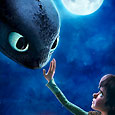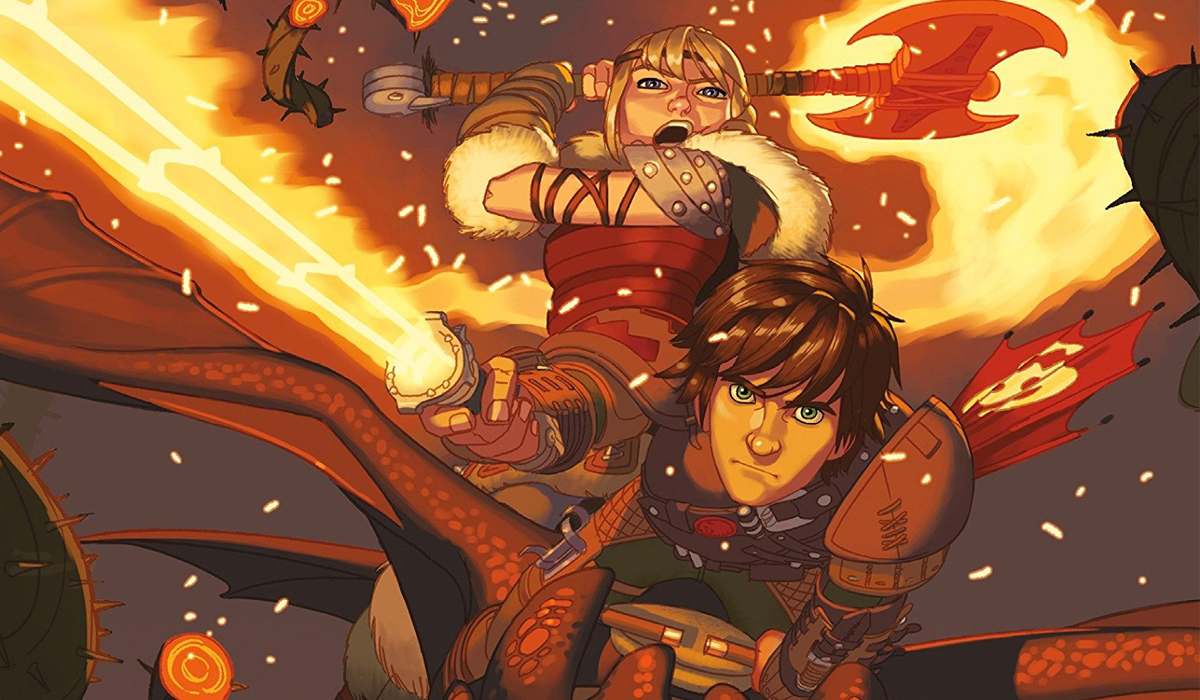If there is one thing every other animation studio could learn from DreamWorks it is this: when talent is out there snatch it up! For years DreamWorks has gone after the biggest celebrities to voice their films (to varying degrees of success). With How to Train Your Dragon they got some big names behind the “camera”, and the result is spectacular. The credits read like a “who’s who” of people involved with the best non-DreamWorks animated films of the past 15 years: Chris Sanders (the director of Lilo and Stitch), Dean DeBlois (the head writer of Mulan), Bonnie Arnold (producer on Toy Story and Tarzan), Darren Holmes (film editor of The Iron Giant and Ratatouille), John Powell (composer of Happy Feet and Horton Hears a Who). Also brought in was eight-time Oscar nominated cinematographer Roger Deakins (Fargo, O Brother, Where Art Thou, No Country for Old Men) — a live action filmmaker who brought new eyes to the look of the production. With all this talent behind the scenes, in addition to the in-house talent DreamWorks has to draw on, it’s no wonder this film easily ranks as one of the studio’s best.
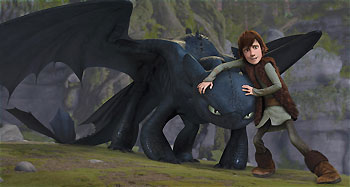 In a viking village, dragons are an ever-looming threat. The lives of the brawny townsfolk are all centered around fighting and killing the beasts. Hiccup, son of the viking leader, is neither strong nor adept at fighting, but he tries to make up for it in enthusiasm and cleverness. Unfortunately his efforts usually end up making things worse. Wanting to fit in and finally make his father proud of him, he sets his sights on killing a Night Fury, a dragon that has never been captured, killed, or even seen by any viking. He successfully manages to knock one out of the sky, but is unable to finish the job. But he soon discovers there might be another way of becoming a great dragon hunter.
In a viking village, dragons are an ever-looming threat. The lives of the brawny townsfolk are all centered around fighting and killing the beasts. Hiccup, son of the viking leader, is neither strong nor adept at fighting, but he tries to make up for it in enthusiasm and cleverness. Unfortunately his efforts usually end up making things worse. Wanting to fit in and finally make his father proud of him, he sets his sights on killing a Night Fury, a dragon that has never been captured, killed, or even seen by any viking. He successfully manages to knock one out of the sky, but is unable to finish the job. But he soon discovers there might be another way of becoming a great dragon hunter.
Boiled down to the basics, yes, this is your typical boy-that-is-different-wants-to-prove-himself-to-everyone-and-gain-approval-of-dad story that’s been done many times over. But the setting, the style, and the storytelling make it feel almost brand new. The pace of the story is pitch-perfect: ramping up to manic when necessary, slowing down when we need to catch our breath or catch a plot point, but it never gets too frantic or too plodding. While the action aspects are obviously a big draw here they don’t feel overwhelming. The story is never drowned under the excitement. While I usually am not a proponent of the hip/cool anachronistic type of humor, that is mainly because it usually doesn’t work or is off-putting. When it does work, it is because it fits the character not because it fits the audience they are trying to attract. Madagascar is an example where it fit and it worked. Fortunately (though it was admittedly not as pronounced as most films that use it) the modern-ish Hiccup worked. The charcter needs to feel like an outsider and this was an effective means of conveying that. Surprisingly few pop culture or bodily function jokes fill the script. And more importantly the story and jokes aren’t split for adults and kids. As all the best animated films do, all ages will find something to enjoy at the same time — not because each joke is tailored for a different demographic.
Hiccup as a lead may be one of the strongest in the canon. Don’t be turned off by first impressions. He’s a very sympathetic character that audiences are going to love. Witty, independent, smart, and brave — they may have the making of a franchise leader here. While not up to the Pixar crying-your-eyes-out standard, the emotional pull in the relationship between the characters is off the chart by DreamWorks standards. Whether it’s between Hiccup and his father, Hiccup and the dragon Toothless, or even Hiccup and his crush Astrid, all the marks are hit square on. These characters may be the most well-rounded ever created by the studio. With the Shrek franchise closing this year, DreamWorks may have found a cast people care enough about to center their company branding behind.
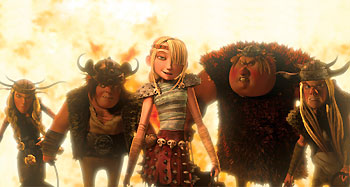 Two years ago, Kung Fu Panda did things with the camera during fight scenes that were extremely impressive. How to Train Your Dragon is just as impressive but improves in a significant way. Where Panda’s animation fell to by-the-numbers quality outside the fight scenes, Dragon is just as striking when things slow down. Every new scene and location were fully formed. Forests felt lush, the village felt lived in, and everything just felt like a little extra care had been taken to get it just right. But they didn’t take it to the other extreme. In contrast to most other DreamWorks films, this movie felt less crowded. Rather than filling every scene with too much minutia or creating sets that seemed to end at the film’s edges, How to Train Your Dragon had an openness to it. Wide clearings, vast skies, and interior sets that felt like they probably created the whole building and you could walk all the way through them. Another nice surprise was the subtlety of the animated “performances”. I’m talking about simple things you might not notice when they’re not there but add nuance to the characters and their changing relationships: a tiny reaction to a touch or a hint of a sidewards glance. These are the types of responses real people have without thinking but are often glossed over in the broad strokes of animation. Character designs were fun and mostly appealing — as appealing as vikings and dragons can be! I’m still not a fan of the look of most humans in DreamWorks’ films, but here things seemed a little less harsh. The many dragon designs are the showstoppers. While dragons have been around in movies for years, DreamWorks was able to get in some unique twists of their own.
Two years ago, Kung Fu Panda did things with the camera during fight scenes that were extremely impressive. How to Train Your Dragon is just as impressive but improves in a significant way. Where Panda’s animation fell to by-the-numbers quality outside the fight scenes, Dragon is just as striking when things slow down. Every new scene and location were fully formed. Forests felt lush, the village felt lived in, and everything just felt like a little extra care had been taken to get it just right. But they didn’t take it to the other extreme. In contrast to most other DreamWorks films, this movie felt less crowded. Rather than filling every scene with too much minutia or creating sets that seemed to end at the film’s edges, How to Train Your Dragon had an openness to it. Wide clearings, vast skies, and interior sets that felt like they probably created the whole building and you could walk all the way through them. Another nice surprise was the subtlety of the animated “performances”. I’m talking about simple things you might not notice when they’re not there but add nuance to the characters and their changing relationships: a tiny reaction to a touch or a hint of a sidewards glance. These are the types of responses real people have without thinking but are often glossed over in the broad strokes of animation. Character designs were fun and mostly appealing — as appealing as vikings and dragons can be! I’m still not a fan of the look of most humans in DreamWorks’ films, but here things seemed a little less harsh. The many dragon designs are the showstoppers. While dragons have been around in movies for years, DreamWorks was able to get in some unique twists of their own.
Powell’s score was fitting, and at the times it came through the action it was very beautiful and effective. This is definitely a soundtrack you’d want to listen to outside the movie. The audio editing was a little off. For example, when Hiccup is flying up into the air on Toothless and then dives, his voice never changes volume or pitch. It’s as if he wasn’t even moving. Maybe it was done for clarity, but I found it a little off-putting as it took me out of the moment in its unrealism.
Despite what I thought based on the trailers, I actually ended up liking the voice acting in the film. Jay Baruchel’s unique take on Hiccup ended up being just right, setting him apart (as necessitated by the plot) from the Scottish brogue of the adult vikings and the more normal voices of the other kids. It also was a natural fit with the style of humor his character had. If you didn’t like it in the commercials give it a chance and I think you’ll come around too. Gerard Butler as Hiccup’s father and Craig Ferguson as his boss give solid if uninspired performances. Nothing wrong with them, mind you, but nothing that couldn’t have been done with any other Scottish accented actor. America Ferrera fits nicely as the tomboyish Astrid.
How to Train Your Dragon proves that Kung Fu Panda was no fluke. DreamWorks has once again raised the bar for themselves and the competition. Bringing in and keeping top talent is a smart strategy other studios would be wise to start following. DreamWorks has already proved they are a commercial equal to their main rival Pixar. Soon they could position themselves as a critical equal as well.
Animated Classic or Back To The Drawing Board?
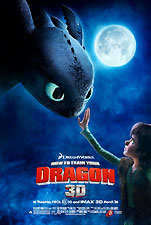 |
How To Train Your Dragon
DreamWorks Animation March 26, 2010 98 minutes Rated PG directed by Chris Sanders & Dean DeBlois
|



